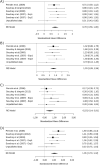Episodic and semantic feeling-of-knowing in aging: a systematic review and meta-analysis
- PMID: 37777585
- PMCID: PMC10542372
- DOI: 10.1038/s41598-023-36251-9
Episodic and semantic feeling-of-knowing in aging: a systematic review and meta-analysis
Abstract
A complex pattern of preservation and deterioration in metacognition in aging is found, especially regarding predicting future memory retrieval (i.e., feeling-of-knowing, FOK). While semantic FOK (sFOK) is preserved with age, studies on episodic tasks (eFOK) produce equivocal findings. We present a meta-analysis of 20 studies on eFOK and sFOK, analyzing the difference in metacognitive sensitivity between 922 younger and 966 older adults, taking into account the difference in memory performance. The sFOK studies yielded no overall age effect (8 effects, g = -0.10 [-0.29, 0.10]). However, we found a reliable age-group difference on eFOK (22 effects, g = 0.53 [0.28, 0.78]), which was moderated when considering recognition performance. Moreover, using aggregated data of 134 young and 235 older adults from published and unpublished studies from our lab, we investigated memory performance as an explanation of the eFOK deficit. We show that older adults are less metacognitively sensitive than younger adults for eFOKs which is, at least partly, due to the age-related memory decline. We highlight two non-exclusive explanations: a recollection deficit at play in the first and second order tasks, and a confound between first order performance and the measure used to assess metacognitive sensitivity.
© 2023. Springer Nature Limited.
Conflict of interest statement
The authors declare no competing interests.
Figures








References
Publication types
MeSH terms
LinkOut - more resources
Full Text Sources
Miscellaneous

